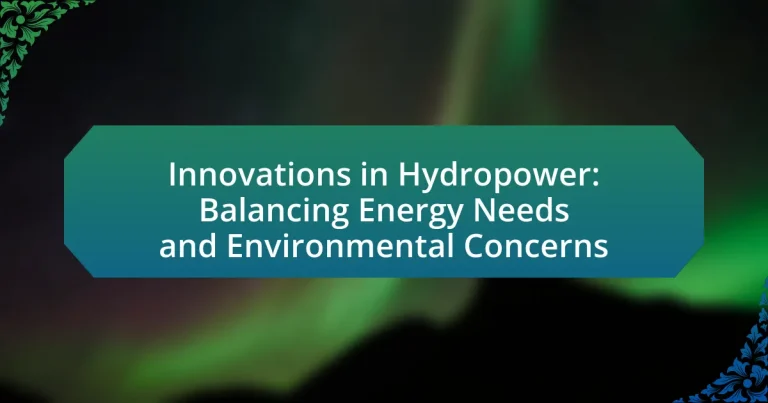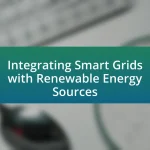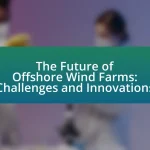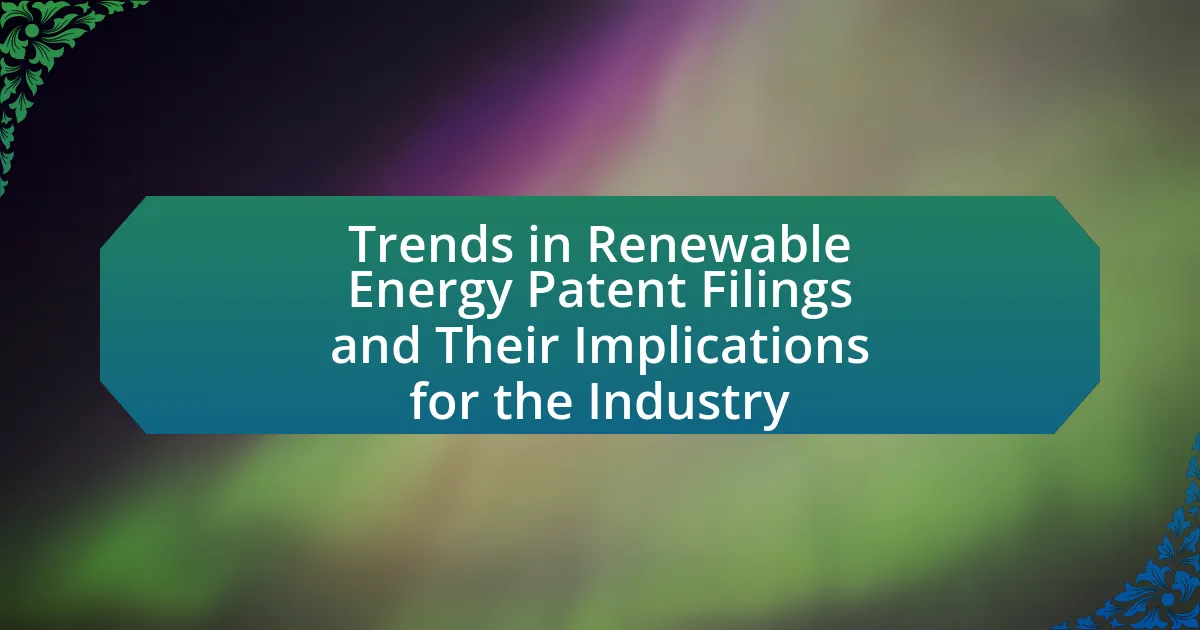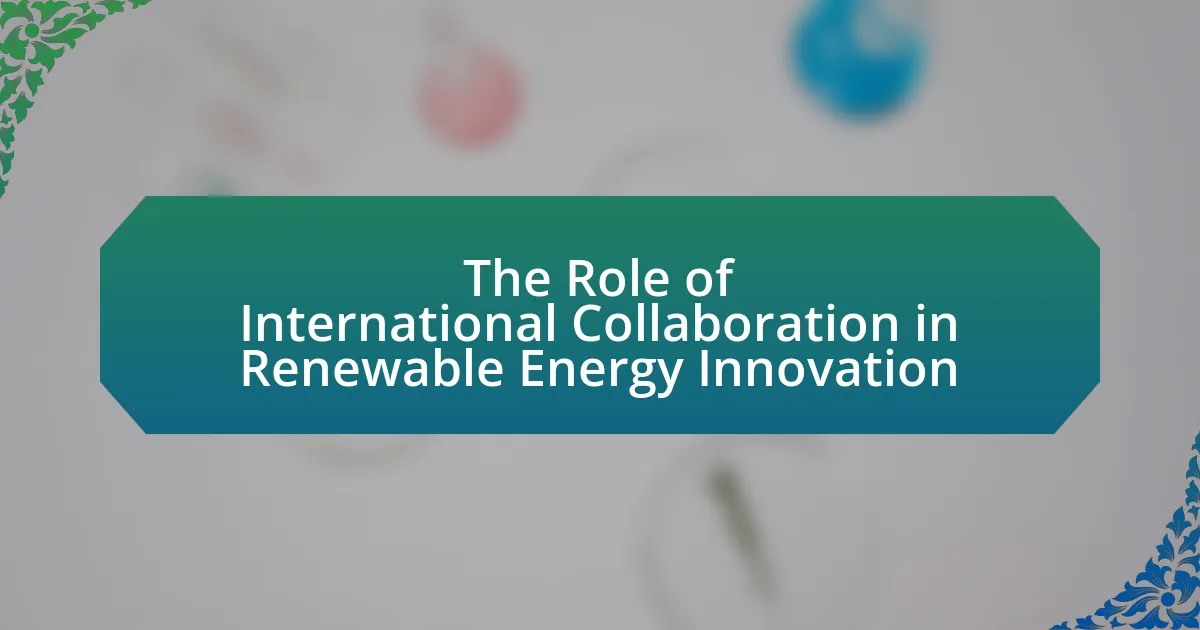The article focuses on innovations in hydropower technology, emphasizing the balance between energy production and environmental sustainability. Key advancements include the development of advanced turbine designs, such as fish-friendly turbines, and the integration of digital monitoring systems that enhance operational efficiency. The article explores how these innovations improve energy efficiency, reduce operational costs, and address environmental concerns, particularly regarding aquatic life. Additionally, it discusses the challenges faced by the hydropower industry, the role of regulatory frameworks, and strategies for stakeholder engagement to ensure successful project outcomes. Emerging technologies and best practices for integrating hydropower with other renewable energy sources are also highlighted, showcasing the future trends in sustainable hydropower development.
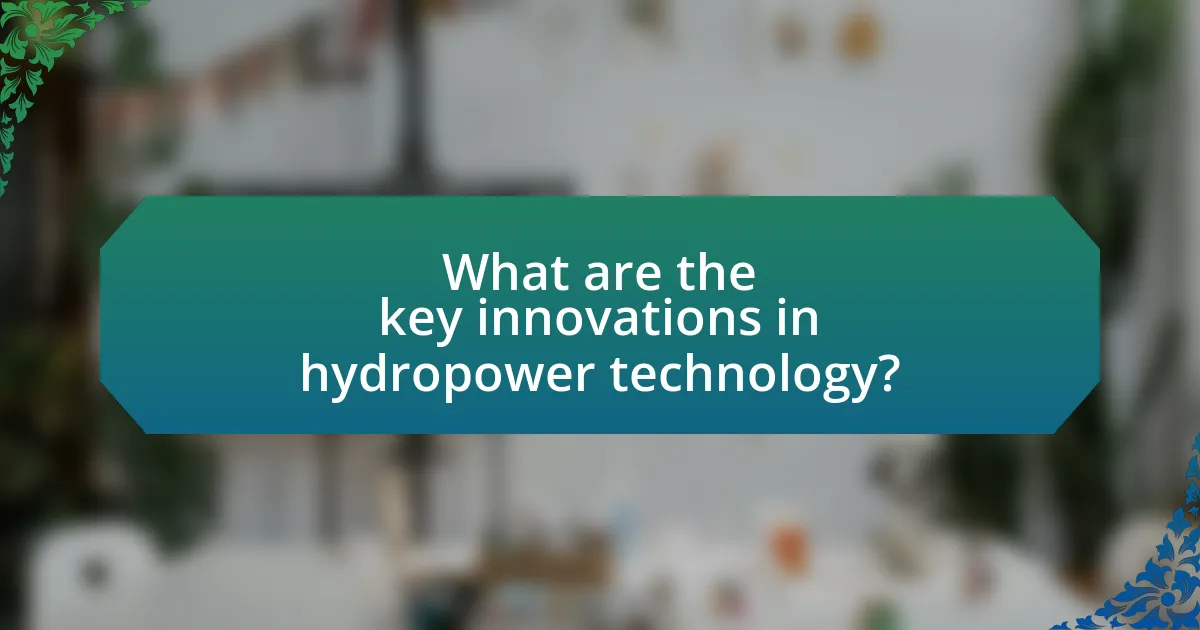
What are the key innovations in hydropower technology?
Key innovations in hydropower technology include the development of advanced turbine designs, such as fish-friendly turbines, and the integration of digital monitoring systems. Advanced turbine designs enhance efficiency and reduce environmental impact by allowing safe passage for aquatic life, as demonstrated by the use of the Kaplan turbine, which can operate effectively in low-flow conditions. Digital monitoring systems utilize real-time data analytics to optimize performance and maintenance, improving operational efficiency and reducing downtime. These innovations collectively contribute to more sustainable and efficient hydropower generation, addressing both energy needs and environmental concerns.
How do these innovations improve energy efficiency?
Innovations in hydropower improve energy efficiency by enhancing turbine designs and optimizing water flow management. Advanced turbine technologies, such as variable-speed turbines, allow for better adaptation to varying water conditions, resulting in increased energy capture and reduced energy losses. Additionally, smart grid integration enables real-time monitoring and management of energy production, which maximizes output and minimizes waste. For instance, studies have shown that implementing these innovations can increase the overall efficiency of hydropower plants by up to 20%, demonstrating their significant impact on energy efficiency.
What specific technologies enhance energy conversion rates?
Specific technologies that enhance energy conversion rates in hydropower include advanced turbine designs, variable speed generators, and digital control systems. Advanced turbine designs, such as Kaplan and Francis turbines, optimize water flow and increase efficiency, achieving conversion rates above 90%. Variable speed generators allow for better adaptation to fluctuating water flow, improving overall energy capture. Digital control systems enhance operational efficiency by optimizing performance in real-time, leading to increased energy output. These technologies collectively contribute to maximizing energy conversion rates in hydropower systems.
How do innovations reduce operational costs in hydropower plants?
Innovations reduce operational costs in hydropower plants by enhancing efficiency and optimizing maintenance processes. Advanced technologies such as predictive maintenance, which utilizes data analytics and IoT sensors, allow for real-time monitoring of equipment, reducing downtime and maintenance costs. For instance, the implementation of machine learning algorithms can predict equipment failures before they occur, leading to timely interventions that prevent costly outages. Additionally, innovations in turbine design, such as the development of more efficient turbine blades, can increase energy output while minimizing wear and tear, further lowering operational expenses. These advancements collectively contribute to a more cost-effective and sustainable operation of hydropower facilities.
What role does digital technology play in modern hydropower?
Digital technology plays a crucial role in modern hydropower by enhancing efficiency, optimizing operations, and improving maintenance practices. Advanced data analytics and real-time monitoring systems allow for precise management of water flow and energy production, leading to increased output and reduced operational costs. For instance, the integration of Internet of Things (IoT) devices enables continuous performance tracking, which can identify potential issues before they escalate, thereby minimizing downtime. Additionally, predictive maintenance powered by machine learning algorithms can forecast equipment failures, ensuring that maintenance is performed proactively rather than reactively. These technological advancements not only boost the reliability of hydropower plants but also contribute to more sustainable energy production by optimizing resource use and reducing environmental impact.
How is data analytics transforming hydropower operations?
Data analytics is transforming hydropower operations by enhancing efficiency, optimizing maintenance, and improving decision-making processes. Through the use of predictive analytics, operators can forecast water flow and energy production, leading to better resource management. For instance, data-driven models can analyze historical weather patterns and reservoir levels to optimize turbine operations, resulting in a reported increase in energy output by up to 15% in some facilities. Additionally, real-time monitoring systems enable proactive maintenance, reducing downtime and operational costs. This integration of data analytics not only boosts productivity but also supports environmental sustainability by minimizing the ecological impact of hydropower generation.
What are the benefits of remote monitoring and control systems?
Remote monitoring and control systems provide significant benefits, including enhanced operational efficiency, real-time data access, and improved decision-making capabilities. These systems enable operators to monitor hydropower facilities from remote locations, reducing the need for on-site personnel and minimizing operational costs. For instance, a study by the International Renewable Energy Agency (IRENA) highlights that remote monitoring can lead to a 20% increase in operational efficiency by allowing for timely maintenance and quick response to anomalies. Additionally, these systems facilitate better resource management and environmental monitoring, ensuring compliance with regulations while optimizing energy production.
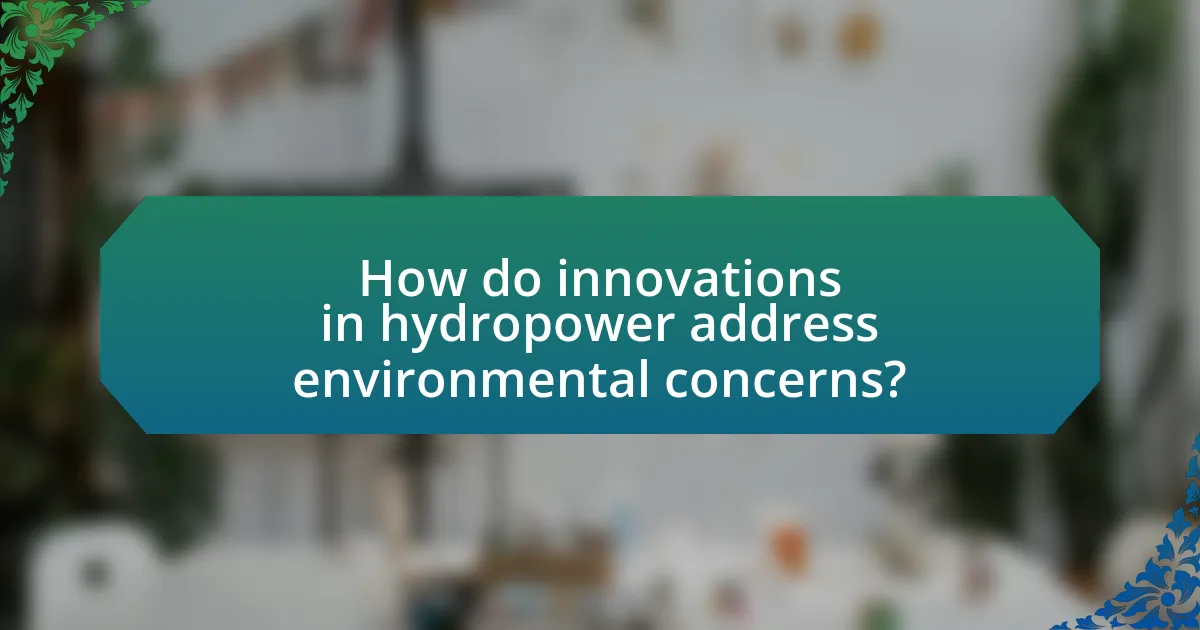
How do innovations in hydropower address environmental concerns?
Innovations in hydropower address environmental concerns by implementing technologies that minimize ecological disruption and enhance sustainability. For instance, the development of fish-friendly turbines reduces fish mortality rates, allowing aquatic life to thrive while still generating energy. Additionally, advancements in run-of-river systems limit the need for large reservoirs, thereby preserving natural habitats and reducing greenhouse gas emissions associated with traditional hydropower plants. Research indicates that these innovations can lead to a 90% reduction in fish mortality compared to conventional turbines, demonstrating their effectiveness in balancing energy production with environmental protection.
What are the environmental impacts of traditional hydropower systems?
Traditional hydropower systems have significant environmental impacts, primarily including habitat alteration, water quality degradation, and disruption of aquatic ecosystems. The construction of dams alters river flow, which can lead to the flooding of large areas, displacing wildlife and changing local ecosystems. Additionally, the stagnation of water in reservoirs can result in reduced oxygen levels, promoting harmful algal blooms that affect water quality. Research indicates that these systems can disrupt fish migration patterns, leading to declines in fish populations, particularly species that rely on upstream spawning grounds. For instance, studies have shown that dams can reduce fish populations by up to 90% in some river systems, highlighting the severe ecological consequences of traditional hydropower.
How do new designs minimize ecological disruption?
New designs in hydropower minimize ecological disruption by incorporating features such as fish-friendly turbines, sediment management systems, and adaptive flow regimes. These innovations reduce the impact on aquatic ecosystems by allowing fish to pass through turbines safely, maintaining natural sediment transport, and adjusting water flow to mimic natural river conditions. For instance, studies have shown that fish-friendly turbines can decrease fish mortality rates by up to 90%, significantly enhancing biodiversity in affected waterways. Additionally, adaptive flow regimes help preserve the natural habitat of aquatic species, further mitigating ecological disruption.
What measures are taken to protect aquatic life in hydropower projects?
Measures taken to protect aquatic life in hydropower projects include the implementation of fish passage systems, habitat restoration, and environmental flow management. Fish passage systems, such as fish ladders and bypass channels, facilitate the movement of aquatic species around dams, ensuring their migration patterns are not disrupted. Habitat restoration efforts focus on rehabilitating riverbanks and aquatic ecosystems affected by construction, promoting biodiversity. Environmental flow management involves regulating water releases to mimic natural flow patterns, which supports the ecological health of aquatic habitats. These measures are supported by studies indicating that effective fish passage systems can increase fish populations by up to 50% in some regions, demonstrating their importance in maintaining aquatic life.
How can hydropower projects be made more sustainable?
Hydropower projects can be made more sustainable by implementing fish-friendly turbine designs, optimizing water flow management, and integrating renewable energy sources. Fish-friendly turbines, such as those developed by companies like Voith and GE, reduce fish mortality rates by allowing safe passage for aquatic life, thus preserving biodiversity. Optimizing water flow management through real-time monitoring systems can enhance ecological balance by ensuring that water releases mimic natural river conditions, which supports local ecosystems. Additionally, integrating renewable energy sources, such as solar or wind, with hydropower systems can provide a more stable and diversified energy supply, reducing reliance on single-source energy generation. These strategies collectively contribute to minimizing environmental impacts while maximizing energy output.
What role do renewable materials play in hydropower construction?
Renewable materials play a crucial role in hydropower construction by enhancing sustainability and reducing environmental impact. The use of materials such as bamboo, recycled steel, and sustainably sourced timber minimizes carbon footprints and promotes eco-friendly practices. For instance, bamboo’s rapid growth and strength make it an ideal choice for certain structural components, while recycled steel reduces the demand for new raw materials, thereby conserving resources. Studies indicate that incorporating renewable materials can lead to a significant decrease in greenhouse gas emissions associated with construction processes, aligning with global sustainability goals.
How do innovations in water management contribute to sustainability?
Innovations in water management significantly enhance sustainability by optimizing resource use and minimizing environmental impact. Advanced techniques such as smart irrigation systems reduce water waste by delivering precise amounts of water to crops, which can lead to a 30% decrease in water usage, as reported by the Food and Agriculture Organization. Additionally, the implementation of rainwater harvesting systems captures and utilizes stormwater, reducing reliance on traditional water sources and mitigating flooding risks. These innovations not only conserve water but also promote ecosystem health by maintaining natural water cycles and reducing pollution runoff.
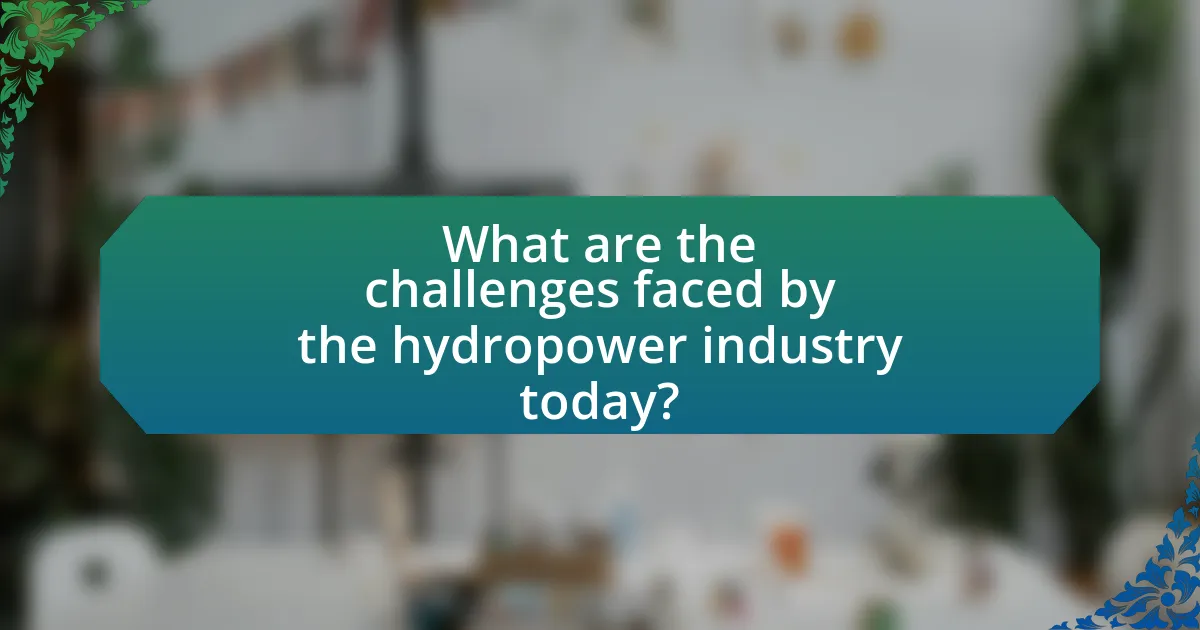
What are the challenges faced by the hydropower industry today?
The hydropower industry today faces several significant challenges, including environmental concerns, regulatory hurdles, and aging infrastructure. Environmental concerns arise from the impact of dam construction on aquatic ecosystems and fish migration, which can lead to biodiversity loss. Regulatory hurdles often involve complex permitting processes that can delay project development and increase costs. Additionally, aging infrastructure poses risks of inefficiency and safety hazards, as many existing facilities require upgrades or replacements to meet modern standards. These challenges necessitate innovative solutions to balance energy production with ecological preservation and infrastructure modernization.
How do regulatory frameworks impact hydropower innovations?
Regulatory frameworks significantly influence hydropower innovations by establishing guidelines that dictate project feasibility, environmental standards, and funding opportunities. These frameworks can either promote or hinder technological advancements; for instance, stringent environmental regulations may encourage the development of more efficient and eco-friendly hydropower technologies, while overly restrictive policies can stifle innovation by increasing costs and project delays. Evidence of this impact is seen in countries like Norway, where supportive regulatory environments have led to the adoption of advanced turbine designs and improved water management practices, enhancing both energy production and ecological sustainability.
What are the barriers to implementing new technologies in hydropower?
The barriers to implementing new technologies in hydropower include high initial capital costs, regulatory challenges, and environmental concerns. High initial capital costs can deter investment, as new technologies often require significant financial resources for development and installation. Regulatory challenges arise from complex permitting processes and compliance with environmental regulations, which can delay project timelines and increase costs. Additionally, environmental concerns, such as the impact on aquatic ecosystems and local communities, can lead to public opposition and further complicate the implementation of new technologies. These factors collectively hinder the advancement and adoption of innovative solutions in the hydropower sector.
How does public perception influence hydropower development?
Public perception significantly influences hydropower development by shaping policy decisions, funding availability, and project feasibility. When communities view hydropower positively, they are more likely to support initiatives, leading to smoother regulatory processes and increased investment. Conversely, negative perceptions, often stemming from environmental concerns or social impacts, can result in public opposition, legal challenges, and project delays. For instance, a study by the International Hydropower Association found that projects with strong community engagement and positive public sentiment are 30% more likely to succeed compared to those facing opposition. Thus, public perception acts as a critical determinant in the successful implementation of hydropower projects.
What strategies can be employed to overcome these challenges?
To overcome the challenges in balancing energy needs and environmental concerns in hydropower, strategies such as implementing advanced turbine technology, enhancing fish passage systems, and adopting adaptive management practices can be employed. Advanced turbine technology, like fish-friendly turbines, minimizes harm to aquatic life while maximizing energy generation efficiency. Enhancing fish passage systems, such as fish ladders and bypass channels, ensures that migratory species can navigate around dams, thus preserving biodiversity. Adaptive management practices involve continuous monitoring and adjusting operations based on environmental impact assessments, which allows for a more sustainable approach to hydropower development. These strategies collectively address the dual objectives of energy production and ecological preservation, demonstrating a commitment to sustainable hydropower solutions.
How can stakeholder engagement improve project outcomes?
Stakeholder engagement can significantly improve project outcomes by fostering collaboration, enhancing communication, and ensuring that diverse perspectives are considered. Engaging stakeholders in hydropower projects allows for the identification of potential environmental concerns early in the planning process, which can lead to more sustainable solutions. For instance, studies have shown that projects with active stakeholder involvement are 30% more likely to meet their objectives on time and within budget, as they benefit from shared knowledge and resources. This collaborative approach not only mitigates risks but also builds trust among stakeholders, leading to greater support and smoother implementation of hydropower initiatives.
What best practices can enhance the acceptance of hydropower projects?
Engaging local communities through transparent communication and inclusive decision-making processes enhances the acceptance of hydropower projects. Studies show that when stakeholders, including local residents, are involved early in the planning stages, their concerns are addressed, leading to greater support. For instance, the International Hydropower Association highlights that projects with strong community engagement strategies report up to 30% higher acceptance rates. Additionally, implementing environmental impact assessments and demonstrating commitment to sustainability can further build trust and acceptance among stakeholders.
What are the future trends in hydropower innovation?
Future trends in hydropower innovation include the integration of advanced technologies such as digital monitoring systems, small modular hydropower plants, and enhanced turbine designs. Digital monitoring systems utilize IoT and AI to optimize performance and maintenance, leading to increased efficiency and reduced operational costs. Small modular hydropower plants offer flexible, scalable solutions that can be deployed in diverse environments, addressing energy needs without significant ecological disruption. Enhanced turbine designs, including fish-friendly turbines, aim to minimize environmental impacts while maximizing energy output. These innovations are supported by a growing emphasis on sustainability and the need for renewable energy sources, as evidenced by the International Renewable Energy Agency’s report highlighting hydropower’s role in achieving global energy transition goals.
How will climate change influence hydropower development?
Climate change will significantly influence hydropower development by altering water availability and flow patterns. Increased temperatures and changing precipitation patterns can lead to reduced snowpack and earlier snowmelt, which affects river flow during critical periods for energy generation. For instance, studies indicate that regions like the western United States may experience a decrease in streamflow by up to 20% by mid-century due to climate change, impacting the reliability of hydropower as a renewable energy source. Additionally, extreme weather events, such as droughts and floods, can disrupt hydropower operations and infrastructure, necessitating adaptations in design and management practices to ensure sustainability and efficiency in energy production.
What emerging technologies are on the horizon for hydropower?
Emerging technologies on the horizon for hydropower include advanced turbine designs, small modular hydropower systems, and hydrokinetic energy converters. Advanced turbine designs, such as fish-friendly turbines, enhance efficiency while minimizing ecological impact, addressing environmental concerns. Small modular hydropower systems allow for decentralized energy generation, making hydropower accessible in remote areas and reducing infrastructure costs. Hydrokinetic energy converters harness energy from flowing water without the need for large dams, thus preserving aquatic ecosystems. These innovations collectively aim to improve energy efficiency and sustainability in hydropower generation.
What practical steps can be taken to balance energy needs and environmental concerns in hydropower?
To balance energy needs and environmental concerns in hydropower, implementing run-of-river systems is essential. These systems generate electricity without the need for large reservoirs, thereby minimizing ecological disruption and preserving river ecosystems. Additionally, integrating fish passage solutions, such as fish ladders or bypass systems, ensures that aquatic life can migrate freely, maintaining biodiversity. Employing advanced turbine technology can also enhance efficiency while reducing environmental impact, as modern turbines are designed to minimize harm to fish populations. Furthermore, conducting thorough environmental impact assessments before project initiation allows for informed decision-making that considers both energy production and ecological preservation. These steps collectively contribute to a sustainable approach in hydropower development.
How can project developers incorporate community feedback into hydropower planning?
Project developers can incorporate community feedback into hydropower planning by implementing structured engagement processes, such as public consultations and surveys. These methods allow developers to gather insights on local concerns, preferences, and suggestions regarding the project. For instance, a study by the International Hydropower Association highlights that involving communities in the planning phase can lead to more sustainable and accepted projects, as it addresses potential environmental and social impacts early on. Additionally, integrating feedback mechanisms, such as community advisory boards, ensures ongoing dialogue and adaptation of project plans based on community input, thereby enhancing project legitimacy and support.
What are the best practices for integrating hydropower with other renewable energy sources?
The best practices for integrating hydropower with other renewable energy sources include optimizing the use of hydropower as a flexible resource, implementing hybrid systems, and enhancing grid management. Hydropower can provide backup and stability to intermittent sources like solar and wind, allowing for a more reliable energy supply. Hybrid systems, which combine hydropower with solar or wind, can maximize energy generation and reduce reliance on fossil fuels. Effective grid management, including advanced forecasting and demand response strategies, ensures that energy from various sources is efficiently utilized, maintaining balance and reliability in the energy supply. These practices are supported by studies showing that regions employing integrated renewable energy systems experience improved energy security and reduced greenhouse gas emissions.
